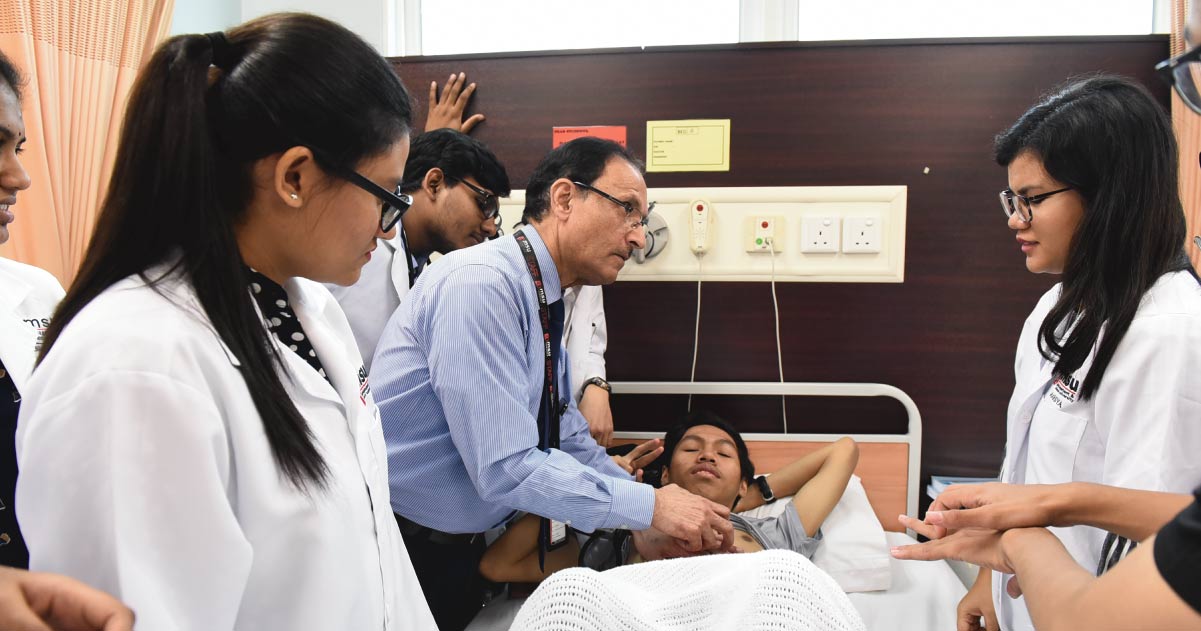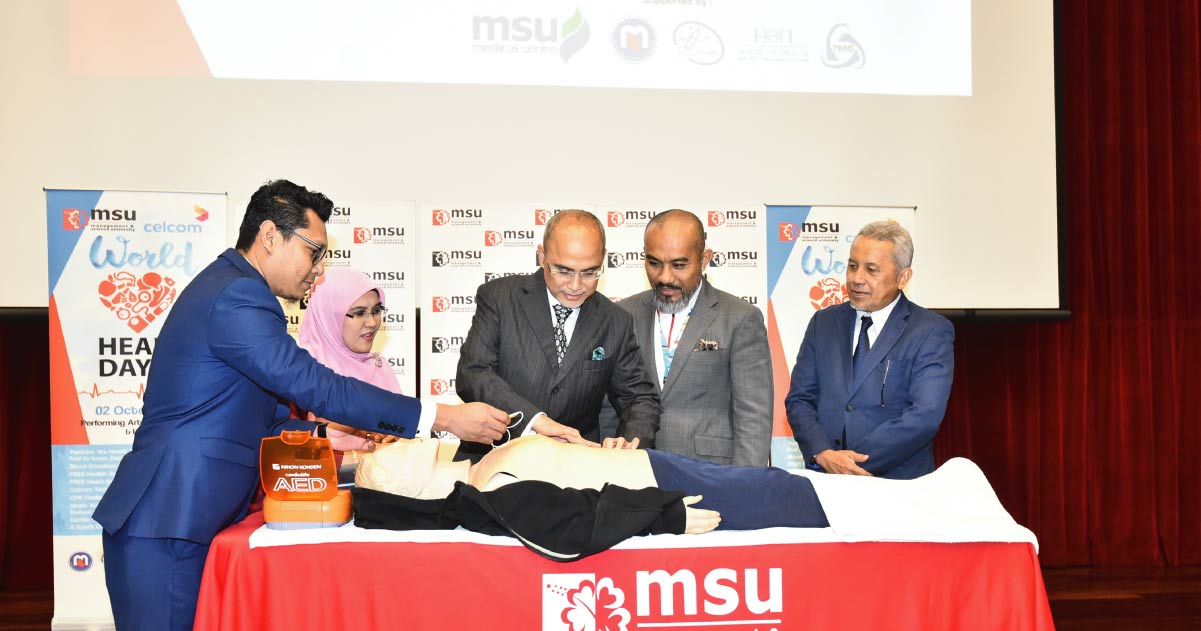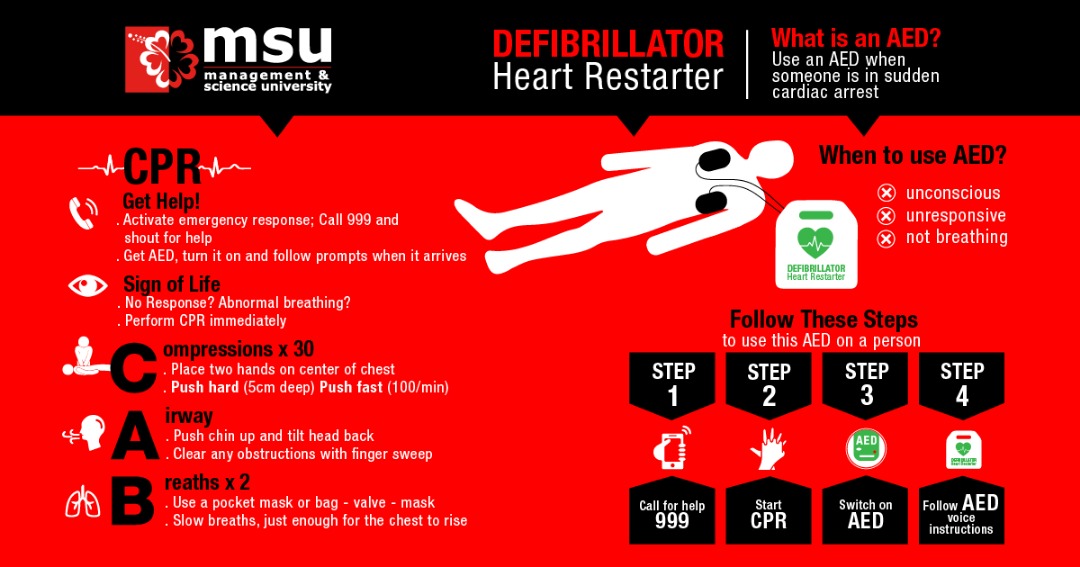

A heart attack can happen to anyone, at any time and any place. It comes without warning, but by learning in advance how to use an AED you will be better equipped to save a life.
AED or Automated External Defibrillator is a device used to deliver therapeutic electric shock to the heart as treatment for a victim experiencing sudden cardiac arrest (SCA). Its availability and prompt use have been shown to save people’s lives in many cases of SCA. It is safe to use on a non-breathing child aged 8 or older who weighs more than 55 pounds, or an adult. A manual defibrillator would be more suitable for infant victims.
What happens to the heart in SCA and how does the AED work?

In a cardiac arrest, most of the time the problem is electrical; some of the heart muscles contract, while some others relax. The heart goes into a fatal rhythm called ventricular fibrillation, which stops the pumping of blood. When blood-flow to the brain stops, the patient collapses. A shock through the heart depolarizes it so it can start beating normally again.
What to do when you see someone collapse and become unresponsive?
First, shout and/or rub the person’s chest bone hard with your knuckles to determine responsiveness. Call medical emergency services or command someone else to make that call. Start cardiopulmonary resuscitation (CPR) by continuous chest compression on the patient. Tell someone to get an AED while you continue with the chest compression CPR.

When the AED arrives, turn it on and follow its instructions. An AED is fail-proof as the voice prompts will walk you through each step.
“Begin by removing all clothing from the patient’s chest. Cut clothing if needed.”
“When patient’s chest is bare, remove protective cover (of the AED) and take out. Look carefully at the pictures on the white adhesive pads.”
“Peel one pad from the yellow plastic liner. Place pad exactly as shown in the picture. Press firmly to the patient’s bare skin.”
Make sure that the patient’s bared skin is dry. If there is perspiration, wipe it dry first. Note also that one electrode pad should be placed just below the right clavicle, and the other on the left side just below the breast level.

As a rule, if a straight line were to be drawn between the two electrodes, it should pass through the centre of the heart. The electrodes will analyze whether a shock is necessary.
“Analyzing.”
“Shock advised.”
“Stay clear of patient.”
“Press the flashing orange button.”
No one, including you, should be touching the patient when the electrode pads are in place. When shock is advised, observe staying clear of the patient before pushing the shock button.
“Shock delivered.”
“Be sure that medical emergency services have been called.”
The chest compressions should resume until the paramedics arrive.
How do AED and Continuous Chest Compression CPR work together?
Whilst continuous chest compression CPR pumps blood to the brain and other organs, an AED is necessary to restore regular rhythm.
Shocking a ventricular fibrillation as soon as it happens is crucial. That is how implanted automatic defibrillators work. If nothing happens for a long time from the onset of fibrillation, the muscles weaken from energy loss and no blood. If you shock them at this point, nothing will happen anymore that can help the heart.
On the other hand, a cardiac massage keeps profusing the heart. It helps increase chances for the heart surviving in case the shocking can only come later.

MSU Bachelor in Cardiovascular Technology (Honours)
MSU Bachelor of Medical Sciences (Honours)
MSU Foundation (Science Biology / Health Science)
A heart attack can happen to anyone, at any time and any place. It comes without warning, but by learning in advance how to use an AED you will be better equipped to save a life.
AED or Automated External Defibrillator is a device used to deliver therapeutic electric shock to the heart as treatment for a victim experiencing sudden cardiac arrest (SCA). Its availability and prompt use have been shown to save people’s lives in many cases of SCA. It is safe to use on a non-breathing child aged 8 or older who weighs more than 55 pounds, or an adult. A manual defibrillator would be more suitable for infant victims.
What happens to the heart in SCA and how does the AED work?

In a cardiac arrest, most of the time the problem is electrical; some of the heart muscles contract, while some others relax. The heart goes into a fatal rhythm called ventricular fibrillation, which stops the pumping of blood. When blood-flow to the brain stops, the patient collapses. A shock through the heart depolarizes it so it can start beating normally again.
What to do when you see someone collapse and become unresponsive?
First, shout and/or rub the person’s chest bone hard with your knuckles to determine responsiveness. Call medical emergency services or command someone else to make that call. Start cardiopulmonary resuscitation (CPR) by continuous chest compression on the patient. Tell someone to get an AED while you continue with the chest compression CPR.

When the AED arrives, turn it on and follow its instructions. An AED is fail-proof as the voice prompts will walk you through each step.
“Begin by removing all clothing from the patient’s chest. Cut clothing if needed.”
“When patient’s chest is bare, remove protective cover (of the AED) and take out. Look carefully at the pictures on the white adhesive pads.”
“Peel one pad from the yellow plastic liner. Place pad exactly as shown in the picture. Press firmly to the patient’s bare skin.”
Make sure that the patient’s bared skin is dry. If there is perspiration, wipe it dry first. Note also that one electrode pad should be placed just below the right clavicle, and the other on the left side just below the breast level.

As a rule, if a straight line were to be drawn between the two electrodes, it should pass through the centre of the heart. The electrodes will analyze whether a shock is necessary.
“Analyzing.”
“Shock advised.”
“Stay clear of patient.”
“Press the flashing orange button.”
No one, including you, should be touching the patient when the electrode pads are in place. When shock is advised, observe staying clear of the patient before pushing the shock button.
“Shock delivered.”
“Be sure that medical emergency services have been called.”
The chest compressions should resume until the paramedics arrive.
How do AED and Continuous Chest Compression CPR work together?
Whilst continuous chest compression CPR pumps blood to the brain and other organs, an AED is necessary to restore regular rhythm.
Shocking a ventricular fibrillation as soon as it happens is crucial. That is how implanted automatic defibrillators work. If nothing happens for a long time from the onset of fibrillation, the muscles weaken from energy loss and no blood. If you shock them at this point, nothing will happen anymore that can help the heart.
On the other hand, a cardiac massage keeps profusing the heart. It helps increase chances for the heart surviving in case the shocking can only come later.

MSU Bachelor in Cardiovascular Technology (Honours)
MSU Bachelor of Medical Sciences (Honours)
MSU Foundation (Science Biology / Health Science)